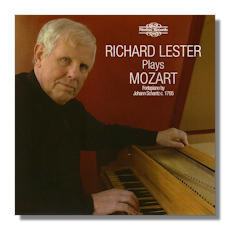
The Internet's Premier Classical Music Source
Related Links
- Mozart Reviews
- Latest Reviews
- More Reviews
-
By Composer
-
Collections
DVD & Blu-ray
Books
Concert Reviews
Articles/Interviews
Software
Audio
Search Amazon
Recommended Links
Site News
 CD Review
CD Review
Wolfgang Mozart

Piano Works
- Sonata in D Major, K 311 (1777)
- Sonata in C Major, K 330 (1783)
- Variations on "Ah vous drai-je, maman", K 265 (1781/2)
- Sonata in C Major, K 545 (1788)
- Sonata in A Major, K 331 (1783)
Richard Lester, fortepiano
Nimbus NI5867
Fresh from his acclaimed and completed series of all Scarlatti's sonatas and ongoing survey of keyboard works by Frescobaldi – all also on Nimbus – Richard Lester has a new and welcome CD containing four sonatas and the variations on "Ah vous drai-je, maman" (K265) by Mozart. Significantly, Lester uses a fortepiano (by Johann Schantz, built around 1795) in what is part of a recital given at the Holburne Museum in Bath (England) in March 2007. The CD is just over an hour in length with applause but otherwise minimal audience sounds. Though there is atmosphere.
Lester's playing is full of life. It has a nice blend of the formal and tight with spontaneity and an outgoing feel. Just what these works need. Importantly, Lester's technique (never obtrusive, for all the intricacies of certain passages) "pulls the music through the keyboard", so to speak; and lets Mozart's moments of joy, bewilderment, mischief, wistfulness and sheer exuberance present themselves at all times. Richard Lester is a musician who's always very interested in the instrument at hand; he's also well aware of the advantages of period instruments, including those of the Classical period. Yet he never overstates the case. He brings out the characteristics of both Mozart's solo keyboard writing and the fortepiano in equal measure – because that is what Mozart wanted. Specifically, his playing feasts upon the lighter touch offered by the fortepiano, which allow its dynamics to reveal every detail of Mozart's tracery. This intimacy of tone and delicacy of musical line are key aspects of this recital. So, as Lester modestly suggests in his liner note, are the slight imperfections that necessarily creep into live performances when mechanisms over 200 years old are concerned. There is nothing, though, to spoil or intercept our enjoyment of this live recital; nor that of the audience, by the sound of it.
In 1777 Mozart was very taken with a new fortepiano by Andreas Stein and enumerated its qualities in a letter to his father. The instrument was fast growing in caché… Haydn requested an advance from his publishers in order to buy one. As the fashion became a vogue and the vogue deepened into a movement, the rounded nature of the fortepiano's tone drew admirers and adherents commensurate – so would say its advocates these days – with that light yet sonorous sound. Contemporaries stress the elegance, the grace, the refinement and the gentility which the fortepiano somehow actually seemed to confer upon those who played it. In Lester's choice of works and his approach to interpreting them, lightness and delicacy are never confused with caution or reticence. The music is there to be played and heard. And so it is.
Indeed, the works on this CD, all written between 1777 and 1788, point up the virtues and strengths of the fortepiano in the closing decades of the eighteenth century. Lester also manages successfully to play in such a way that the influence which the instrument's characteristics exercised on the composers of the period – in this case Mozart – is paramount in our understanding of what they wrote as well as how they wrote it. For example, the juxtaposition of bravura with lyrical movements (as in the D Major, K311 [tr.s 1-3]) without either undue abruptness or too great contrasts. Or the interest which could be built on the repurposing of an otherwise well-known (to the English-speaking world it's "Twinkle twinkle little star") theme so that it assumes a new texture altogether thanks to the fortepiano's lighter touch. Even the more transparent, flowing, effect of the Alberti bass in K545 sounds fresh and more impactful on the fortepiano. Lester never overstates this though. But the consonance between "effect" and instrument is hard to overlook. Altogether a pleasing recital of familiar works played well in what may be an unfamiliar style.
The booklet gives useful background on the works and on the fortepiano. The fortepiano is not the star of this show. But its mellow and yet trenchant tone contribute almost to awarding it that status. Lester's is not the only recording of these pieces on the instrument (Brautigam's on BIS are also to be considered), but it's a worthy and insightful one.
Copyright © 2011, Mark Sealey.





















